《跨文化交际与翻译》 (5)
- 格式:pptx
- 大小:114.10 KB
- 文档页数:20
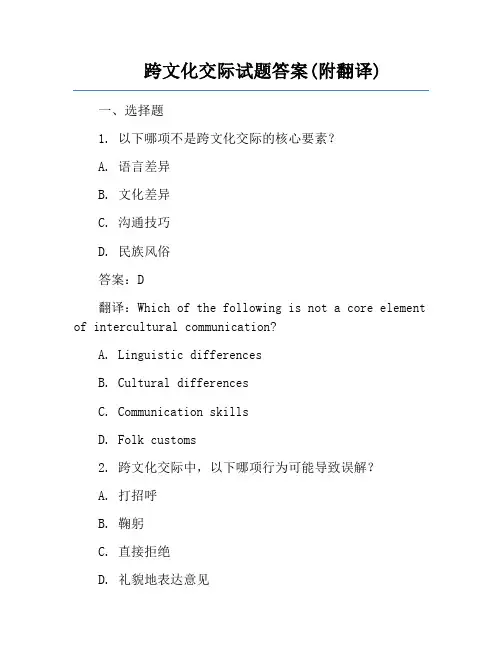
跨文化交际试题答案(附翻译)一、选择题1. 以下哪项不是跨文化交际的核心要素?A. 语言差异B. 文化差异C. 沟通技巧D. 民族风俗答案:D翻译:Which of the following is not a core element of intercultural communication?A. Linguistic differencesB. Cultural differencesC. Communication skillsD. Folk customs2. 跨文化交际中,以下哪项行为可能导致误解?A. 打招呼B. 鞠躬C. 直接拒绝D. 礼貌地表达意见翻译:In intercultural communication, which behavior may lead to misunderstandings?A. GreetingB. BowingC. Direct refusalD. Politely expressing opinions二、填空题1. 跨文化交际中的文化差异主要体现在____、____、____等方面。
答案:价值观、行为规范、语言使用翻译:The cultural differences in intercultural communication are mainly reflected in values, behavioral norms, and language use.2. 跨文化交际能力包括____、____、____等方面。
答案:知识、技能、态度翻译:Intercultural communication competence includes knowledge, skills, and attitudes.三、简答题1. 简述跨文化交际的重要性。
跨文化交际在全球化背景下具有重要意义。
以下是跨文化交际的重要性:(1)促进国际交流与合作:跨文化交际有助于不同国家和地区的人们相互了解,增进友谊,促进国际合作。
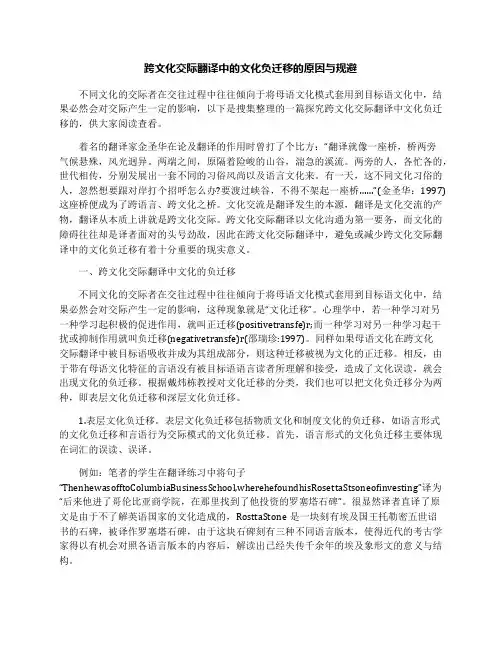
跨文化交际翻译中的文化负迁移的原因与规避不同文化的交际者在交往过程中往往倾向于将母语文化模式套用到目标语文化中,结果必然会对交际产生一定的影响,以下是搜集整理的一篇探究跨文化交际翻译中文化负迁移的,供大家阅读查看。
着名的翻译家金圣华在论及翻译的作用时曾打了个比方:“翻译就像一座桥,桥两旁气候悬殊,风光迥异。
两端之间,原隔着险峻的山谷,湍急的溪流。
两旁的人,各忙各的,世代相传,分别发展出一套不同的习俗风尚以及语言文化来。
有一天,这不同文化习俗的人,忽然想要跟对岸打个招呼怎么办?要渡过峡谷,不得不架起一座桥……”(金圣华:1997)这座桥便成为了跨语言、跨文化之桥。
文化交流是翻译发生的本源,翻译是文化交流的产物,翻译从本质上讲就是跨文化交际。
跨文化交际翻译以文化沟通为第一要务,而文化的障碍往往却是译者面对的头号劲敌,因此在跨文化交际翻译中,避免或减少跨文化交际翻译中的文化负迁移有着十分重要的现实意义。
一、跨文化交际翻译中文化的负迁移不同文化的交际者在交往过程中往往倾向于将母语文化模式套用到目标语文化中,结果必然会对交际产生一定的影响,这种现象就是“文化迁移”。
心理学中,若一种学习对另一种学习起积极的促进作用,就叫正迁移(positivetransfe)r;而一种学习对另一种学习起干扰或抑制作用就叫负迁移(negativetransfe)r(邵瑞珍:1997)。
同样如果母语文化在跨文化交际翻译中被目标语吸收并成为其组成部分,则这种迁移被视为文化的正迁移。
相反,由于带有母语文化特征的言语没有被目标语语言读者所理解和接受,造成了文化误读,就会出现文化的负迁移。
根据戴炜栋教授对文化迁移的分类,我们也可以把文化负迁移分为两种,即表层文化负迁移和深层文化负迁移。
1.表层文化负迁移。
表层文化负迁移包括物质文化和制度文化的负迁移,如语言形式的文化负迁移和言语行为交际模式的文化负迁移。
首先,语言形式的文化负迁移主要体现在词汇的误读、误译。


1.纵观历史,我们可以清楚地看到,各民族与文化由于彼此所处地域、意识形态、容貌服饰和行为举止上存在的差异,而长久无法互相理解,无法和睦相处。
在这种情况下,跨文化交际作为一个特定的研究领域得以形成和发展。
值得注意的是,人类文明在发展过程中所遭受的许多挫折,既是个人的,又是全球性的;人类历史进程总是充满了个人间的直接冲突和民族间的误解--从骂骂咧咧到孤立主义甚至到武装冲突,大大小小争端不绝。
很显然,文化间以及亚文化间的交往日益增多,这迫切要求我们共同努力,去理解与我们有着天壤之别信仰和文化背景的人们,并与之和睦相处。
通过加深认识和理解,我们能够与生活方式、价值观念不同的人们和平共处;这不但有益于我们周遭环境的安定,也是维护世界和平的决定性因素。
2.文化有时候被称为我们的心智程序,也即我们“头脑的软件”。
但是,我们可以进一步引申这个用电脑所做的类比,把文化看作是支持软件运行的操作环境。
文化就像电脑使用的DOS或者Unix或者“视窗”(Windows)等操作系统一样,使我们能在各种各样的实际应用中处理信息。
用“视窗”这个比喻来描述文化似乎也很有吸引力。
文化就是我们心灵的视窗,透过它我们可以审视生活的方方面面。
一个社会中不同个体的视窗是大不一样的,但都有着一些重要的共同特征。
文化就好像是鱼畅游于其中的水一般,人们想当然地把文化看成是客观存在的事实,从而很少去研究它。
文化存在于我们所呼吸的空气之中,文化对我们了解自我是必不可少的,就正如生命离不开空气一样。
文化是特定群体的共有财产,而不单是个体的特征。
社会按照文化设定的程序来运作,这种程序来自于相似的生活体验以及对这种生活体验之涵义的相似性阐释。
如果文化是一种心智程序,那么它也是现实的心灵地图。
从我们很小的时候开始,文化就告诉我们应该看重什么、偏好什么、规避什么以及做些什么。
文化还告诉我们事物应该是什么样的。
文化为我们提供超越个体经验的理想典范,帮助我们决定应该优先考虑什么。

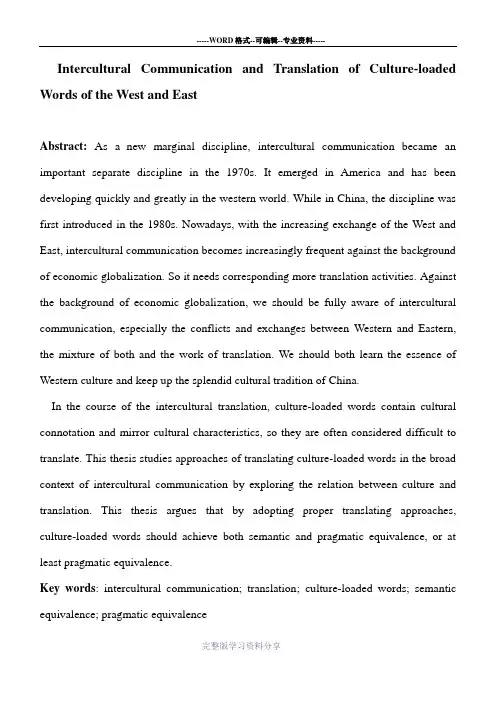
Intercultural Communication and Translation of Culture-loaded Words of the West and EastAbstract:As a new marginal discipline, intercultural communication became an important separate discipline in the 1970s. It emerged in America and has been developing quickly and greatly in the western world. While in China, the discipline was first introduced in the 1980s. Nowadays, with the increasing exchange of the West and East, intercultural communication becomes increasingly frequent against the background of economic globalization. So it needs corresponding more translation activities. Against the background of economic globalization, we should be fully aware of intercultural communication, especially the conflicts and exchanges between Western and Eastern, the mixture of both and the work of translation. We should both learn the essence of Western culture and keep up the splendid cultural tradition of China.In the course of the intercultural translation, culture-loaded words contain cultural connotation and mirror cultural characteristics, so they are often considered difficult to translate. This thesis studies approaches of translating culture-loaded words in the broad context of intercultural communication by exploring the relation between culture and translation. This thesis argues that by adopting proper translating approaches, culture-loaded words should achieve both semantic and pragmatic equivalence, or at least pragmatic equivalence.Key words: intercultural communication; translation; culture-loaded words; semantic equivalence; pragmatic equivalenceIntroductionIntercultural communication involves two different cultures, and different culture created a different national language. Culture plays an important role in specific semantic structure and model of language. The vocabulary is the accumulation of cultural information, and the cultural concepts and values of different nation at all levels of culture are "reflected in their vocabulary system, and then form the words with cultural connotation." [1]With special cultural connotation, cultural words are often difficult in cross-cultural communication translation, and even become an obstacle to transmission of information.Influence of culture on translationFrom the perspective of intercultural communication, one of the purposes is to establish the cultural equivalence between the source language and target language. In terms of the translation of cultural terms, the cultural equivalence mainly reflects in the semantic equivalence and pragmatic equivalence. Semantic equivalence is the basis of pragmatic equivalence. Thus, in many cases, equivalent translation is also mainly refers to the semantic equivalence.The author believes that the basic principles of cultural lexicon translation should be done to maximize the semantic and pragmatic equivalence. We should at least ensure the pragmatic equivalence if semantic equivalence can not be achieved. For instance, in Tianjin city of China, there is a century-old snack "Goubuli" steamed buns, and now many tourist cities in the country establish its branches, and the buns are also soldabroad. Its English translation "Dog Won't Leave" is far from its original Chinese name meaning. And there is no semantic equivalent at all, because the Chinese "dog ignore" have no contact with “the dog” and “leave”. However, from the perspective of pragmatic translation, “Dog Won't Leave” is a wonderful translation. Dogs won’t leave buns stands for it will not leave its host either. Undoubtedly, such translation has a strong attraction force for diners in English and America who love dogs like loving friends. Basically, the equivalence in pragmatic effects is achieved.As the source language and target language are different in language and culture, it is almost impossible to achieve totally equivalence in semantic and pragmatic aspect for the source language and target language symbols. Therefore, when translating cultural words, we only try to pursuit of semantic equivalence as far as possible under the premise of ensuring pragmatic equivalence. There are five commonly used methods when translating cultural words:First, shift translation. It refers to unchanged moving all or part of the source language to the target language. For instances, CD, VCD, DVD, DNA, ICU, and many computer terms which are translated into Chinese by the shift frequently appear on Chinese newspapers and magazines. Some expressions with Chinese characteristics like qigong (qigong), taijiquan (shadow boxing), jiaozi (dumplings), qipao (cheongsam), has moved in English and American newspapers.Second, transliteration. Some of the source language culture-specific images are "blank" or "vacant” in the target language. I n this case, we can transplant these unique to the target language using transliteration method. Transliteration is homophonic inChinese words or word combinations in English translation, and these words or word combinations are not meaningful ready-made words in Chinese. For instance: 秀(show), 酷(cool), 黑客(hacker), 艾滋病(AIDS), 色拉(salad), 可口可乐(Coca-cola) and so on.Third, literal translation. Literal translation refers to translation of the "corresponding" phrase and cultural information in the source language. This can preserve cultural identity of the source language as much as possible and broaden the cultural horizons of target language readers. However, it can not be applied mechanically, and it should not mislead the reader of the target language. For instance: olive branch (橄榄树), lonely as a cloud (像一朵孤云), 纸老虎(paper tiger),一国两制(one country with two systems), etc.Four, free translation. It focuses on the translation to convey the original meaning (interpretation), which lay down the language form and literal meaning of the source language. It expresses the cultural information of source language in the target language with cross-cultural "pragmatic equivalence. For instance: the Renaissance (文艺复兴); "辛亥革命"(the 1911 Revolution against Qing Dynasty), etc.Five, Replacement. It refers to the replacement of original words with some similar meaning but different concept meaning in the target language on the basis of keeping communication meaning of the original. That is to replace words with rich cultural connotation in the source language with corresponding word with same cultural connotation in the target language. Such as: to laugh off one's head (笑掉大牙); lead a dog's life (过着牛马不如的生活); 挥金如土(to spend money like water); 力大如牛(asstrong as a horse).ConclusionEnglish and Chinese are two different languages, and both reflect the cultural differences which form the barrier of communication. How to overcome obstacles and achieve cultural equivalence is a difficult problem to solve. Practice shows that in most cases we can find reasonable translation methods which can be accepted by readers in the target language. By means of the necessary modifications, we can at least achieve pragmatic equivalence. The important thing is that the translators should attach great importance to cultural factors in the source language, and consider issues from the purpose of intercultural communication.。
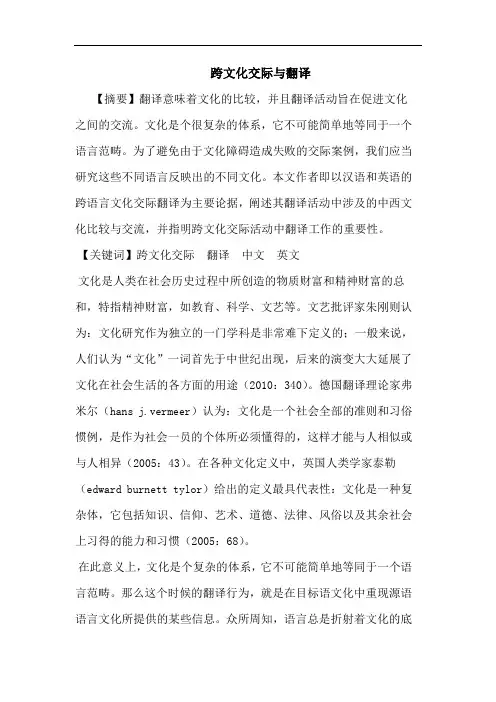
跨文化交际与翻译【摘要】翻译意味着文化的比较,并且翻译活动旨在促进文化之间的交流。
文化是个很复杂的体系,它不可能简单地等同于一个语言范畴。
为了避免由于文化障碍造成失败的交际案例,我们应当研究这些不同语言反映出的不同文化。
本文作者即以汉语和英语的跨语言文化交际翻译为主要论据,阐述其翻译活动中涉及的中西文化比较与交流,并指明跨文化交际活动中翻译工作的重要性。
【关键词】跨文化交际翻译中文英文文化是人类在社会历史过程中所创造的物质财富和精神财富的总和,特指精神财富,如教育、科学、文艺等。
文艺批评家朱刚则认为:文化研究作为独立的一门学科是非常难下定义的;一般来说,人们认为“文化”一词首先于中世纪出现,后来的演变大大延展了文化在社会生活的各方面的用途(2010:340)。
德国翻译理论家弗米尔(hans j.vermeer)认为:文化是一个社会全部的准则和习俗惯例,是作为社会一员的个体所必须懂得的,这样才能与人相似或与人相异(2005:43)。
在各种文化定义中,英国人类学家泰勒(edward burnett tylor)给出的定义最具代表性:文化是一种复杂体,它包括知识、信仰、艺术、道德、法律、风俗以及其余社会上习得的能力和习惯(2005:68)。
在此意义上,文化是个复杂的体系,它不可能简单地等同于一个语言范畴。
那么这个时候的翻译行为,就是在目标语文化中重现源语语言文化所提供的某些信息。
众所周知,语言总是折射着文化的底蕴;中英不同的语言也各自反映着不同文化。
忽略文化差异容易造成使译作的读者群大惑不解的局面。
也就是说,源语的读者群所熟知的内容往往令目标语的读者群深感新奇陌生。
我们发现,人们的每一个行为往往都是置于某个具体文化背景之下进行的,本族语者与非本族语者之间的交际、具有不同语言和文化背景的人从事交际的过程被称之为“跨文化交际”(cross-cultural communication)。
在跨文化交际过程中,行为主体必须对对方的语言和文化背景有所了解甚至于熟悉,否则跨文化交际就会产生障碍。

跨文化交际英语-阅读教程课文翻译————————————————————————————————作者: ————————————————————————————————日期:第一单元现代社会依赖于技术创新,而技术创新须依靠知识产权来保障。
越来越多的国家遵守国际条约,实行知识产权保护。
但这方面做得还远远不够。
我们来回顾一下过去,看看缺乏知识产权保护会导致什么样的后果,从而吸取教训。
许多西方公司付出了惨痛的代价才发现,知识产权保障机制还未健全时,在东南亚投资无异于将钱付诸东流。
要进入这些市场,西方公司不仅必须向相关当局说明他们的产品,而且还要说明他们产品的制作过程。
而结果经常是本该受到知识产权保护的产品很快被无耻地抄袭。
盗用知识产权的例子不胜枚举。
例如,美国化学制品巨头杜邦向一亚洲国家引进了一种名叫Londax的著名除草剂,用来除掉稻田里的杂草。
该公司在该产品的研发上投资了数百万美元,而且又投入了2500万美元在当地开设了一家生产厂家。
然而,不到一年以后,一瓶瓶非常廉价的冒牌Londax公然上市了。
冒牌产品和正宗产品除了价格外的唯一区别是冒牌产品的名称是Rondex,用的是蓝色瓶而不是正宗产品用的绿色瓶。
但是,由于冒牌产品的价格比正宗产品的价格低廉许多,它成功毁掉了杜邦公司的投资。
同时它也使得该公司不再愿意投资于新化学制品的研发。
生产Londax的配方本应该被当作是杜邦公司的知识产权。
其他非法使用该配方的公司是犯了偷盗行为,就像盗取了杜邦公司的机器或者该公司的其他财产一样。
不光是产品,在亚洲市场上保护一个品牌也曾经是几乎不可能的事。
就连Kellogg’s玉米片的生产商Kellogg’s公司也发现自己的产品被山寨:Kongal 牌玉米条,连包装也几乎一模一样。
不幸的是,和杜邦公司的事件一样,Kellogg’s公司成功惩罚侵权者的几率几乎为零,因为当地的法律不承认知识产权保护的概念。
幸好,在经过许多轮世贸组织的谈判后,情况大为改观。

论跨文化交际中的翻译策略周建军摘要:文化差异是跨文化交际中的最大障碍。
译者若不能准确地把握民族之间的文化差异,极易造成文化信息的流失,出现文化信息欠额、文化信息超额,甚至文化信息误译等现象。
为了能够保证再现源语的意义的同时,兼顾源语的文化,本文拟对此进行探析,并提出相应的改进策略。
关键词:跨文化交际;翻译策略-、引言作为跨文化交际的桥梁,翻译在其中起着不可或缺的作用。
翻译不仅仅是将一种语言转换成另一种语言,翻译还承载着将源语言中所蕴涵的文化信息准确地传达给目的语读者的使命。
由于各民族发展历程的不同,两民族进行交流时必然存在着文化差异,这也成为跨文化交际中平等对话的最大障碍,而文化差异的处理不当最终导致了文化的流失。
针对跨文化交际翻译中文化信息处理问题,译界学者专家们争论不休。
有人主张异化策略,即以源语言文化为目标,尽量让译语去适应、照顾源语文化及原作者的遣词用字,以加强目的语读者对源文化的了解并接受,同时达到传播源语言传统文化的目的。
另有部分人主张归化策略,即以目的语文化为归宿,尽量适应和照顾目的语文化习惯,以读者的文化背景、接受理解能力为依据,作恰当地处理。
还有学者认为应当综合考虑两者,以真实准确地再现文化信息,并为读者所理解和接受为最终目标。
无论是选择哪种翻译方式,我们都应该持有科学的跨文化翻译观,不可走极端,因为翻译中译者必须遵守“忠实”原则,换而言之,译文必须忠实于原文,以避免出现文化信息的流失。
然而,在实际的跨文化交际翻译中,往往存在着文化信息欠额、文化信息超额,甚至文化信息误译等现象。
此类现象的出现均在不同程度上影响源语言文化信息的正确传递。
二、翻译中的文化不对等现象(一)翻译中文化信息欠额与文化信息超额现象由于社会、经济、观念、民族等的不同,汉英语言所包含的文化信息不同&而读者受到不同俺239翻译研究文化背景的影响对两种语言中的同一事物所引起的联想各不同。
因此,译者翻译概念意义相同,而文化意象半对应或非对应的内容时,若不能准确把握的话,极易出现翻译中的文化信息欠额与文化信息超额现象。
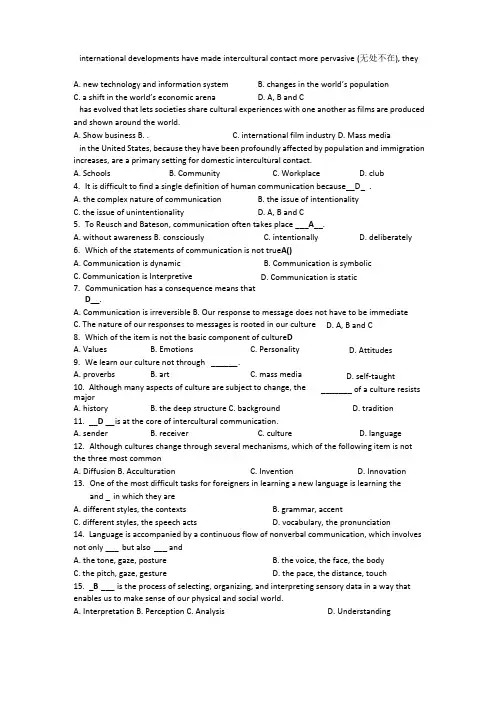
international developments have made intercultural contact more pervasive (无处不在), theyA. new technology and information systemB. changes in the world’s populationC. a shift in the world’s economic arenaD. A, B and Chas evolved that lets societies share cultural experiences with one another as films are produced and shown around the world.A. Show businessB. .C. international film industryD. Mass mediain the United States, because they have been profoundly affected by population and immigration increases, are a primary setting for domestic intercultural contact.A. SchoolsB. CommunityC. WorkplaceD. club4. It is difficult to find a single definition of human communication because__D _ .A. the complex nature of communicationB. the issue of intentionalityC. the issue of unintentionalityD. A, B and C5. To Reusch and Bateson, communication often takes place ___A__.A. without awarenessB. consciouslyC. intentionallyD. deliberately6. Which of the statements of communication is not true A()A. Communication is dynamicB. Communication is symbolicC. Communication is Interpretive 7. Communication has a consequence means thatD__.A. Communication is irreversibleB. Our response to message does not have to be immediateC. The nature of our responses to messages is rooted in our culture 8. Which of the item is not the basic component of culture DA. ValuesB. EmotionsC. Personality 9. We learn our culture not through ______ .A. proverbsB. artC. mass media 10. Although many aspects of culture are subject to change, the majorA. historyB. the deep structureC. backgroundD. tradition11. __D __ i s at the core of intercultural communication.A. senderB. receiverC. cultureD. language12. Although cultures change through several mechanisms, which of the following item is not the three most commonA. DiffusionB. AcculturationC. Invention 13. One of the most difficult tasks for foreigners in learning a new language is learning the and _ in which they areA. different styles, the contextsB. grammar, accentC. different styles, the speech actsD. vocabulary, the pronunciation14. Language is accompanied by a continuous flow of nonverbal communication, which involves not only ___ but also ___ andA. the tone, gaze, postureB. the voice, the face, the bodyC. the pitch, gaze, gestureD. the pace, the distance, touch15. _B ___ is the process of selecting, organizing, and interpreting sensory data in a way that enables us to make sense of our physical and social world.A. InterpretationB. PerceptionC. AnalysisD. Understanding D. Communication is staticD. A, B and CD. AttitudesD. self-taught_______ of a culture resists D. Innovation16.The maps are usually drawn by putting one’s country in the center. This illustrates ___C___.A. MisinterpretationB. Racial biasC. EthnocentrismD. Stereotype17.Many stereotypes are provided by the __D ____ .A. School educationB. TextbookC. HistoryD. Mass media18.Cultural breakdowns, setbacks or conflicts result from misinterpretations, ethnocentrism, and stereotype as a result of B___.A. MisperceptionB. Racial biasC. MisunderstandingD. False impression19.___C__ are defined as “an enduring set of beliefs that serve to guide or direct our behavior”.A. LawsB. PerceptionsC. ValuesD. World views20.Which of the statements about cultural values is not true CA.Cultural values, as is the case with cultural beliefs, guide both perception and communication.B.Cultural values have nothing to do with individual values.C.Cultural values are prescriptive.D.Cultural values, once formed, are enduring and relatively stable.21.Which of the countries doesn’t belong to individualistic culture D()A. ItalyB. New ZealandC. FranceD. Greece22.In a high power distance culture, the superior tends to BA. treat employees respectfullyB. display his authorityC. interact with workers more oftenD. do important work23.Which of the statements about low uncertainty avoidance is not trueA. Divers population.B. Frequent innovations.C. Generally older countries with a long history.D. Citizens are proud of nation.24.Which of the following countries or region of no feminine traits DA. NorwayB. FinlandC. DenmarkD. Austrianguage ____ culturalA. ExpressesB. EmbodiesC. InfluencesD. Symbolizes26.It is a universal truth that language is ___ b y culture and in turn it ______ c ulture. BA. influenced, reflectsB. displayed, influencesC. determined, reflectsD. shaped, influencesnguage is the _____ representation of a people, and it comprises their historical and cultural backgrounds as well as their approach to life and their ways of living andA. PrescriptiveB. AbstractC. SubstantialD. Symbolic28.Which of the contextual cues do not matter in a high-context culture AA.The type of relationship that exists between the speaker and the listener.B.The coded, explicit message.C.Age relative to the speaker and the listener.D.Where is the communication taking place29.The low-context culture doesn’t have which of theA.Tends to develop transitory personal relationship.B.Tends to use "logic" to present ideas.C.Tends to give simple, ambiguous, non-contexting messages.D.Values individualism.30.The following advantages of high-context culturedon’t include A. it saves us making many trivial decisions;B.it allows for great flexibility, adaptability and originality;C.roles tend to be clear;D.group projects and team efforts tend to be practicable and effective.31.People from cultures that prefer “high involvement” styles tend to__A _____ .A.expect to be interruptede polite listening soundC.give plenty of positive and respectful responses to their conversation partnersD.speak one at a time32.People from “high considerateness” cultures are often thought to be _ B___.A. loudB. passiveC. chattyD. pushy33.One way to determine whether a culture favors a direct or indirect style in communication isA .A. How they say, “No.”B. How they invite people.C. How they teach people.D. How they accept people.34.In 2010, the Easter is on ___A ____ .A. 4th, April , April C. 2nd, April D. 6th, April35.Which of the communication style can’t be characterized as high consideratenessAA. ChineseB. JapaneseC. Mainstream AmericanD. RussianDefine the following concept. (4 points for each of the 5 items)(1)Culture (2) Acculturation (3) Stereotype (4) Value (5) Uncertainty avoidance(6) Communication (7) Innovation (8) Perception (9) Ethnocentrism(10) Intercultural communication (11) Power distance (12) high-context True or false.(1)( F ) Cultural generalizations must be viewed not as approximations ( 接近)0£ reality, but as absolute representations.(2)(T ) Domestic contacts are increasing because new immigrants and co-cultures are growing in numbers.(3)( F ) Our response to message has to be immediate.(4)( T ) It is always possible to share our feelings and experiences by means of direct mind-to-mind contact.(5)( T ) Culture is a problem of nurture instead of nature, that is one’s cultural patterns are acquired through learning or interacting, or they are determined by the environment within which we live.(6)( F ) Misinterpretations do result every time members from two cultures communicate.(7)( F ) Ethnocentrism is usually learned at the conscious level.(8)( F) Low uncertainty avoidance cultures tend to have a less efficient infrastructure than high uncertainty avoidance cultures.(9)( T ) China, Korea, Japan, Latin America, and to a certain extent, France, are considered to be high-context cultures.(10)( T ) In the mainstream American culture, the ideal form of communication includes being direct rather than indirect.(11)( T)Communication is an activity that affects people and other people.(12)(T )New technology, and growth in the world’s populationhave contributed to increased international contacts.(13)(F ) All cultures use symbols, but they rarely assign their own meanings to them.(14)( T ) Communication can be retrieved.(15)( ) Patterns of culture are inherent with individual, that is, they are genetically passed down from previous generations.(16)( ) Perceptions for the same object, behavior or event are always universal.(17)( ) To understand other people we must go into their perceptual world and try to experience reality in the same manner as they do.(18)( T ) The Arabic-speaking nations, Latin America, Russia, and nearly all of Asia (especially India and China) are high power distance.(19)( ) Language is influenced and shaped by culture; it reflects culture.(20)( F ) Mainstream American conversation style would also be characterized as “high involvement”, although it differs significantly from the various Asian patterns.(21)( ) We are captives of our culture, though it offers us a common frame of reference.(22)( ) We study other cultures from the perspective of our own culture, so our observations and our conclusion are tainted by our personal and cultural orientations.(23)( ) Because we do not have direct access to the thoughts and feelings of others, we can’t infer what they are experiencing.(24)( ) There are rules for speakers to follow as to how messages are constructed and interpreted.(25)( ) Only when we are deprived of our own culture or put into a completely new culture can we realize the importance of culture to us.(26)( ) Stereotype refers to an unfair, biased, or intolerant attitude towards another group of people.(27)( ) The assumption of similarity is one of the biggest promotions in intercultural communication.(28)( T) Countries or regions with masculine traits are Ireland, the Philippines, Greece, South Africa, Austria, Japan, Italy, and Mexico.(29)( ) Low context communication saves us making many trivial decisions.(30)( F) For Americans, two or three seconds of silence can be comfortable.1.三个国际的发展作出了跨文化联系更普遍的 (无处不在),他们是。
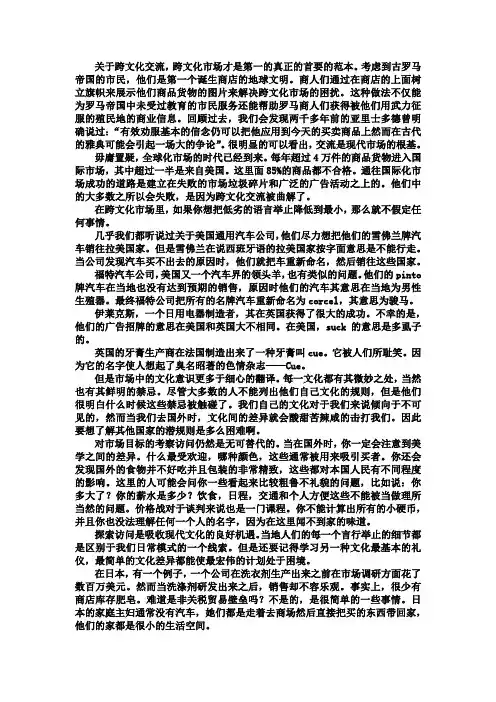
关于跨文化交流,跨文化市场才是第一的真正的首要的范本。
考虑到古罗马帝国的市民,他们是第一个诞生商店的地球文明。
商人们通过在商店的上面树立旗帜来展示他们商品货物的图片来解决跨文化市场的困扰。
这种做法不仅能为罗马帝国中未受过教育的市民服务还能帮助罗马商人们获得被他们用武力征服的殖民地的商业信息。
回顾过去,我们会发现两千多年前的亚里士多德曾明确说过:“有效劝服基本的信念仍可以把他应用到今天的买卖商品上然而在古代的雅典可能会引起一场大的争论”。
很明显的可以看出,交流是现代市场的根基。
毋庸置疑,全球化市场的时代已经到来。
每年超过4万件的商品货物进入国际市场,其中超过一半是来自美国。
这里面85%的商品都不合格。
通往国际化市场成功的道路是建立在失败的市场垃圾碎片和广泛的广告活动之上的。
他们中的大多数之所以会失败,是因为跨文化交流被曲解了。
在跨文化市场里,如果你想把低劣的语言举止降低到最小,那么就不假定任何事情。
几乎我们都听说过关于美国通用汽车公司,他们尽力想把他们的雪佛兰牌汽车销往拉美国家。
但是雪佛兰在说西班牙语的拉美国家按字面意思是不能行走。
当公司发现汽车买不出去的原因时,他们就把车重新命名,然后销往这些国家。
福特汽车公司,美国又一个汽车界的领头羊,也有类似的问题。
他们的pinto 牌汽车在当地也没有达到预期的销售,原因时他们的汽车其意思在当地为男性生殖器。
最终福特公司把所有的名牌汽车重新命名为corcel,其意思为骏马。
伊莱克斯,一个日用电器制造者,其在英国获得了很大的成功。
不幸的是,他们的广告招牌的意思在美国和英国大不相同。
在美国,suck的意思是多虱子的。
英国的牙膏生产商在法国制造出来了一种牙膏叫cue。
它被人们所耻笑。
因为它的名字使人想起了臭名昭著的色情杂志——Cue。
但是市场中的文化意识更多于细心的翻译。
每一文化都有其微妙之处,当然也有其鲜明的禁忌。
尽管大多数的人不能列出他们自己文化的规则,但是他们很明白什么时候这些禁忌被触碰了。
Unit 5Nonverbal communication课前谚语+名言:1、I’s not what he said, but the way he said it.——English saying2、There is a language in her eyes, her cheeks, her lips.——William Shakespeare案例一:个人空间马克最近从丹麦搬到了悉尼,在一家澳大利亚公司当销售员。
他被邀请加入当地的一个俱乐部。
有一天在一个晚会上,一个女成员走近他,马克立即通过谈论展现出了他的兴趣。
起初聊天进行的很顺利,但随着谈话的进行,马克逐渐的向她靠近,而那位女士似乎离他越来越远,并显得很不自在。
当马克正要问她有关于澳大利亚习俗的问题时,站在旁边的一个男士往这边瞟了一眼,她找了个借口离开,去和那个男人说话。
留下马克傻傻的站在那里,他不知道为什么他们的交谈如此突然地停止了。
Question:Why did that women suddenly stop talking with mark and turned to another man?注释:这是一个对身体距离理解不同造成的误会。
在丹麦,正式场合中,个人空间大概在20厘米-30厘米之间。
而在澳大利亚,这样的场合需要40厘米-50厘米的身体距离。
所以丹麦人习惯近距离交谈,澳大利亚人习惯远距离交谈。
在这个情况下,马克尝试去建立自己正常的个人亲密空间,侵犯了澳大利亚女士的空间,正因如此,她感到了某种威胁,失去了舒适感。
就在那时,身旁的男人给了她一个离开的机会。
如果马克对于澳大利亚人所期待的个人空间有所了解的话,或许这个谈话会有所不同。
案例二:使用当地语言的问题。
弗兰克为了做研究的目的从澳大利亚来到中国,为此,他在大学里刻苦学习中文,并且能用中文很方便的和人交流。
而当他到达北京以后,他开始和当地人交谈,询问方向和建议。
尽管他几乎都是用中文和他们交流,但是他发现周围的人有时候会笑着用英语回答他,尽管他们对英语知之甚少。
、案例分析(答题说明:每题10 分,合计分。
) 1. Situation: Two Americans, Bill and Tony, are talking aboutTony's unhappy experience with his Chinese college.Bill: Hi, Tony. How 're you doingTony: Fine. Just got back from visiting the home of one of myChinese colleagues.Bill: Oh, have a good timeTony: Oh yes, very good. Mind you, I was bit hurt about the way they treatedmypresent. You see, I know they like western music so I brought them backsome of the latest tapes from the UK.Had them all wrapped up beautifully and gave them to them as soon as I gotinside the door and what do you think happenedBill: WhatTony: Nothing. Well, more or less, they said thank you but then just put themaway in a corner. Didn 't even bother to unwrapthem. I must say I felt a bit miffed after all the trouble I ' d taken.参考答案:答题点:Gift giving in the West三、跨文化单选(答题说明:每题1分,合计分。
跨文化视角下的英语翻译教学策略——评黄净《跨文化交际与翻译技能》经济全球化背景下,中西方的文化交流呈现出日益密切的态势,培养更多跨文化交际的优质人才,成为新时期对外交流的重要任务。
当前,英语翻译教学的侧重点已经开始发生偏移,许多高校英语教师从跨文化视角出发,尝试多元的英语翻译策略与方法的实施,提高当代大学生的综合素质,使得跨文化交际能力和翻译技能得到全面强化。
在学术领域,关于这一方面的研究不断增多。
其中,关于跨文化视域下的英语翻译教学策略方面的研究,当属黄净于2019年在天津大学出版社出版的《跨文化交际与翻译技能》一书。
该书具有较强的时代性,对当前跨文化交际视野下英语翻译教学策略的制定和实施具有指导意义。
该书的出版定位则是兼具理论和实践导向价值的实用性书籍,主要针对群体是高校英语专业教师、学生,以及相关研究领域的研究者。
全书共分为七个章节。
首先,作者对本研究涉及的理论框架进行了分析,内容中涵盖跨文化交际、翻译和文化翻译的基本概念等;接着分别从跨文化翻译、英汉语言文字差异与翻译、英汉文化语言差异与翻译等方面着手,在对比分析中展现岀研究有效性;然后从跨文化交际视野下的翻译能力和英语翻译及其策略着手,以案例支撑来表现本书研究内容的独有魅力与价值。
通过对该书的品评与深度剖析,发现其具有一定的理论意义,具体表现如下:其一,形成一个完整的理论框架结构。
当前,关于跨文化交际方面的研究内容在不断增多,从这一视角出发的英语翻译教学的尝试也得到了持续深化。
世界范围内文化交流日益密切,对英语翻译专业人才的需求不断增加。
高校作为人才培养的基地,肩负使命。
本书的针对群体则是英语翻译专业的教师和学生群体,书中完整的理论体系框架带来研究的深度与广度,使读者获益。
其二,丰富与完善现有理论体系,为跨文化交际下的英语翻译教学创新指明方向。
书中认为,跨文化交际的核心是要强化文化的认同感,在翻译实践的过程中要意识到语言文字上的差异和文化层面的差异,并学会尊重这种差异,为更好地实现交际和沟通提供保障。
Translation1The growth of intercultural communication as a field of study is based on a view of history that clearly demonstrates people and cultures have been troubled by a persistent inability to understand and get along with groups and societies removed by space, ideology, appearance, and behavior from their own. What is intriguing about many of human civilization’s failure is that they appear to be personal as well as global. The story of humankind is punctuated with instances of face-to-face conflicts as well as international misunderstanding--major and minor quarrels that range from simple name-calling to isolationism tr even armed conflict. It is obvious that increases contact with other cultures and subcultures make it imperative for us to make a concerted effort to understand and get along with people whose beliefs and backgrounds may be vastly different from our own. The ability, through increased awareness and understanding, to peacefully coexist with people who do not necessarily share our lifestyles or values could benefit us not only in our own neighborhoods but could be the decisive factor in maintaining would peace. Translation 2Culture is something referred to as our mental programming, our “software of the mind.”But we can take that computer analogy further and say that culture is the operating environment that enables software programs to run. Culture is like DOS or Unix or Windows:it is what enables us to process information in various specific applications. The metaphor of windows seems to be very appealing to describe culture:culture is a mental set of windows through which all of life is viewed. It varies from individual to individual within a society, but it shares important characteristics with members of a society. Culture is like the water fish swim in--a reality that is taken for granted and rarely examined. It is in the air we breathe and is as necessary to our understanding of who we are as air is to our physical life. Culture is the property of a community people, not simply a characteristic of individuals. Societies are programmed by culture, and that programming comes from similar life experiences and similar interpretations of what those experiences mean. If culture is mental programming, it is also a mental map of reality. It tells us from early childhood what matters, what o prefer, what to avoid, and what to do. Culture also tells us what ought to be . It gives us assumptions about the ideal beyond what individuals may experience. It helps us in setting priorities. It establishes codes for behavior and provides justification and legitimization for that behavior.Translation 3Although each of us has a unique set of values, there also are values that tend to permeate a culture. These are called cultural values. Cultural values generally are normative in that they inform a member of a culture what is good and bad, right and false, positive and negative, and the like. Cultural values define what is worthwhile to die for, what is worth protecting, what frightens people and their social systems, what are considered proper subjects for study and for ridicule, and what types of events lead individuals to group solidarity. Cultural values also specify what behaviors are of importance and which should be avoided within a culture. Values represent a learned organization of rules for making choices and for resolving conflicts. The values held by participants in intercultural communication are important because values develop standards and guidelines that establish appropriate and inappropriate behaviors in a society. V alues, in other words, help determine how people ought to behave with the result that people will exhibit and expect behaviors according to their value systems. To the extent that cultural value systems differ, we may expect that intercultural communication participants will tend to exhibit and to expect different under similar circumstance.Translation 4When we say that language is always ambiguous, what we mean is that we can never fully control the meaning of the things we say and write. The meanings we exchange by speaking and by writing are not given in the words and sentences alone but are also constructed partly out of what our listeners and our readers interpret them to mean. To put this quite another way, meaning in language is jointly constructed by the participants in communication. Language is inherently ambiguous. It means that in order to communicate we must always jump to conclusions about what other mean. There is no way around this. When someone says something, w must jump to some conclusion about what he or she means. We draw inferences based on two main sources. 1, the language they have used, and 2, our knowledge about the world. The knowledge includes expectations about what people would normally say in such circumstances. Language is ambiguous. This means that we can never be certain what the other person means--whether in speaking or writing. To put it another way, language can never fully express our meanings. But what does this mean for intercultural communication? In the first place it should be clear that communication works better the more the participants share assumptions and knowledge about the world. Where two people have very similar histories, backgrounds, and experiences, their communication works fairly easily because the inferences each makes about what the other means will be based on common experience and knowledge. Two people from the same village and the same family are likely to make fewer mistakes in drawing inferences about what the other means than two people from different cities on different sides of the earth.Translation 5Where any two people differ in group membership because they are of different genders, different ages, different ethnic or culture groups, different educations, different parts of the same country or even city, different income or occupational groups, or with very different personal histories, each will find it more difficult to draw inferences about what the other person means.In the contemporary world of international and intercultural communication, the differences between people are considerable. People are in daily contact with members of cultures and other groups from all around the world. Successful communication is based on sharing as much as possible the assumptions we make about what others mean. When we are communicating with people who are very different from us, it is very difficult to know how ti draw inferences about what they mean, and so it is impossible to depend on shared knowledge and background for confidence in our interpretation.It has been found that men and women from the same culture, even from the sane families, often misunderstand each other because of different assumptions they make about the purposes or goals of their communication. A man may wish to make a woman happy by giving her a gift of something she really wants. He asks her what she would like to have for her birthday--- she can ask for anything. Unfortunately, what she wants more than anything else is for him to know intuitively what she would like to have. Men and women, at least in North American society, tend to differ in their concern for explicitness or for indirection. A woman is likely to think it is important for someone to show how well he knows her by not having to ask explicitly what she wants. A man in that situation, however, feels beast about the situation if he is told quiet directly and explicitly how he can make her happy.Translation 6Non-verbal communication might be thought of as any form of communication which is not directly dependent on the use of language. Generally speaking, however, it is very difficult to know where to separate verbal and non-verbal forms of communication. Such non-verbal aspects of communication as nodding the head most often accompany speech and are part and parcel of the verbal system of language use. On the other hand such forms of communication as dance and music often have no verbal component at all. What we want to here is simply to call attention to the fact that many aspects of human interaction depend upon forms of communication which can not be easily transcribed into words and yet are crucial to our understanding to each other.Of course we have to emphasize the importance of communication in speaking and writing, and yet we should also realize that much much communication also takes place without the use of words. The way a person dresses for a meeting may suggestion to other participants how he or she is prepared to participate in it. In fact, we can use virtually any aspect of our behavior or our presentation which others can perceive as means of communication.Translation 7Many people today want to do many things within so little time. The sense o time might be called time urgency, it is a syndrome of behavior in which the persons continually tries to accomplish more than can be humanly accomplished. Until very recently, time urgency was thought to be a characteristics of Americans, particularly American males in the generation born in the period from the Great Depression through to the end of the World War .It should be obvious that that this sense of time urgency is no longer a cultural characteristic of just this one generation of American males. It is a characteristic of the Asian “salary man”, and is spreading throughout the world rapidly as one aspect of the internationalization of business.One of the most important effects of this sense of time is that in communication it will almost produce a negative evaluation to the slower participants by the faster participants. Those who share in this concept of time urgency will come to see anyone who moves more slowly than they do as conservative, as uncooperative, as resistant to change, and as opposing progress. Behind the concept of time urgency is the idea that what lies ahead in the future is always better than what lies behind in the past; it based solidly on the belief in progress.Translation 8If we accept the belief that our past influences our view of reality and the corresponding tenet that each of us may have similar but not identical personal histories, then it should follow that another person’s picture of the universe will not be exactly like ours. Y et most of us act as if our way of perceiving things is the correct and only way. We often overwork perceptual differences and conclude that if the other person doesn’t see that Pablo Picasso is the greatest artist that ever lived, he simply does not art. Actually, it may well be that he has a different past history and what is great art for him may not match our perception of art.In our daily activities these differences in perception appear between different groups. V arious generations, minorities, occupation and cultures have conflicting values and goals that will influence their orientation and interpretation of reality.Our culture is a major of factor in perceptual discrepancies. Culture helps supply us with our perceptive of reality. It therefore plays a dominant role in intercultural communication. Our cultures tell us, in a variety of ways, how to judge others and what to use as criteria for those judgments. The danger of such evaluations is that they are often false, misleading, and arbitrary. It is truly a naive view of the world to believe and behave as if we an our culture have discovered the true and only set of norms.。